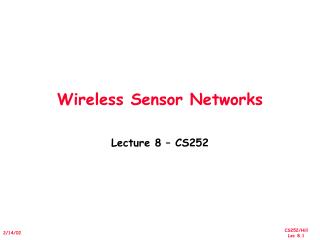
Wireless Sensor Networks in Healthcare. Potential and Challenges. integrate available specialized medical tech. with wireless networks (ex: wearable accelerometers with integrated wireless cards for patient monitoring)

vahe + Follow
Download PresentationAn Image/Link below is provided (as is) to download presentation Download Policy: Content on the Website is provided to you AS IS for your information and personal use and may not be sold / licensed / shared on other websites without getting consent from its author. Content is provided to you AS IS for your information and personal use only. Download presentation by click this link. While downloading, if for some reason you are not able to download a presentation, the publisher may have deleted the file from their server. During download, if you can't get a presentation, the file might be deleted by the publisher.

Wireless Sensor Networks. Lecture 8 – CS252. Sensor Networks: The Vision. Push connectivity out of the PC and into the real world Billions of sensors and actuators EVERYWHERE . Zero configuration Build everything out of CMOS so that each device costs pennies
967 views • 43 slides

Wireless Sensor Networks. CSC 687 Jerry Yoakum. Outline. Overview Environment Monitoring Medical application Data-dissemination schemes Media access control schemes Distributed algorithms for collaborative processing Architecture for a Wireless Sensor Network Final Remarks. Overview.
874 views • 27 slides

Wireless Sensor Networks. Administrivia. Reading Assignment
637 views • 39 slides

Wireless Sensor Networks. Craig Ulmer. Background: Sensor Networks. Array of Sensor Probes (10-1000) Collect In-Situ Data about Environment Wireless Links Relay Data Collaboration. NASA Applications. Primary In-Situ Data Collection Precision Landing Guidance Vehicle Health Sensors
480 views • 18 slides

825 views • 67 slides

Wireless Sensor Networks. Sensory Wireless Ad hoc. Trend of Computers. Large machines PCs Laptops PDAs What is next?. Ubiquitous Computing. Mark Weiser: The most profound technologies are those that disappear.
499 views • 32 slides

Wireless Sensor Networks. - overview -. Wireless Sensor Networks. Introduction Terminology Applications Technical Challenges Examples Conclusion. Introduction.
808 views • 35 slides

Wireless Sensor Networks. Rob Roosendaal, Lecturer INHolland University. Agenda. Introduction Theoretical Background Practical Information Wrap up and questions. Introduction to Wireless Sensor Networks. Our projects. Alzheimer's disease ADL: Activities in Daily Life
820 views • 49 slides

Wireless Sensor Networks. Mixalis Ombashis ECE-654 Advanced Networks Instructor : Dr. Christos Panayiotou. Outline. Introduction Design Factors Fault Tolerance Scalability Production Cost Hardware Constrains … Protocol Stack Physical Layer Data link Layer …
781 views • 43 slides

Wireless Sensor Networks. Somya Kapoor Jorge Chang Amarnath Kolla. Agenda. Introduction and Architecture of WSN –Somya Kapoor. Security threats on WSN – Jorge Chang & Amarnath Kolla. What is WSN?.
648 views • 30 slides

Wireless Sensor Networks. Link Layer Protocols. Mario Č agalj mario.cagalj@fesb.hr FESB University of Split 20 13. Based on “Protocols and Architectures for Wireless Sensor Networks”, Holger Karl , 2005. Data Link Layer services (source: Wiki).
608 views • 37 slides

Wireless Sensor Networks. MOBICOM 2002 Tutorial (Deborah Estrin, Mani Srivastava, Akbar Sayeed). 2006.11.01 Young Myoung,Kang (INC lab) (ymkang@popeye.snu.ac.kr). Contents. Part I : Introduction Part II : Sensor Node Platforms & Energy Issues
551 views • 30 slides

Wireless Sensor Networks. 巨型机说:“我认为全球大概只需要五台计算机就够了”; PC 机说:“每个家庭的桌面上都应该有一台电脑 ”; Pocket PC 说:“太大了,应该每人口袋里放一台 ”; WSN 说:“每粒沙子都应该是一台计算机”。. Outline. General Comments Wireless Sensor Network Applications Architecture of WSN Overview of Sensor Hardware Characteristic of WSN Our Work. Outline.
823 views • 44 slides

Sandra Atijas. Wireless sensor networks. Agenda. Introduction Characteristics Network architecture Sensor node structure Network Applications Network Design Challenges Conclusion. Introduction.
533 views • 33 slides

WIRELESS SENSOR NETWORKS. `. T opics. Introduction What are WSNs? An example: ESB WSN applications Energy conservation Ad-hoc routing Basic principles Overview of routing protocols Data-centric protocols Rumor Routing Geogra phical protocols. Localization and Positioning
1.54k views • 105 slides

Wireless Sensor Networks. A ν. Καθηγητής Συμεών Παπαβασιλείου Εθνικό Μετσόβιο Πολυτεχνείο Τμήμα Ηλεκτρολόγων Μηχανικών και Μηχανικών Υπολογιστών papavass@mail.ntua.gr Τηλ: 210 772-2550. Data gathering in WSN. Issues to consider. Delay :
494 views • 38 slides

WIRELESS SENSOR NETWORKS. By: Reza Abrishambaf. Wireless Sensor Networks. Overview
458 views • 29 slides

Wireless Sensor Networks. Presenter: Carlos Pomalaza-Ráez carlos@ee.oulu.fi International Workshop on Wireless Ad Hoc Networks May 31 – June 3, 2004 University of Oulu, Finland http://www.ee.oulu.fi/~carlos/IWWAN_04_WSN_Tutorial.ppt. Outline. Introduction
1.62k views • 125 slides

Wireless Sensor Networks. Outline. Introduction Sensor Node Platforms & Energy Issues Time & Space Problems in Sensor Networks Sensor Network Protocols. Part I: Introduction. Outline. Introduction Motivating applications Enabling technologies Unique constraints
1.08k views • 77 slides

Wireless Sensor Networks. Link Layer Protocols. Mario Č agalj mario.cagalj@fesb.hr FESB University of Split 23 / 4 /20 10. Based on “Protocols and Architectures for Wireless Sensor Networks”, Holger Karl , 2005. Data Link Layer services (source: Wiki).
460 views • 37 slides